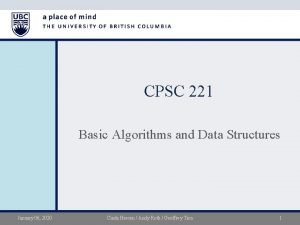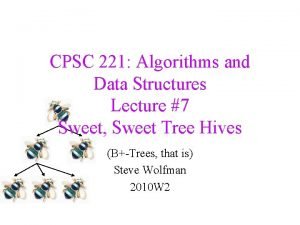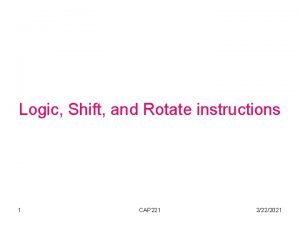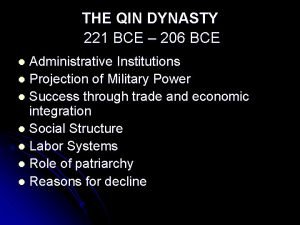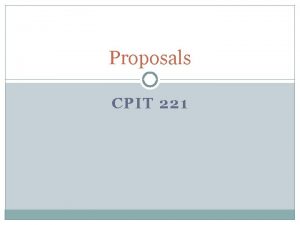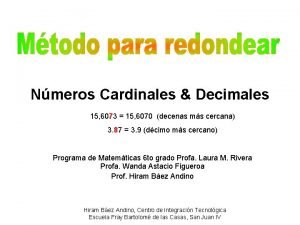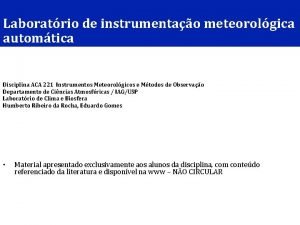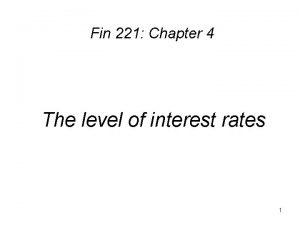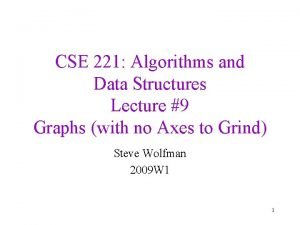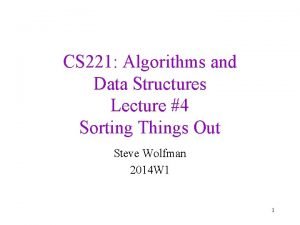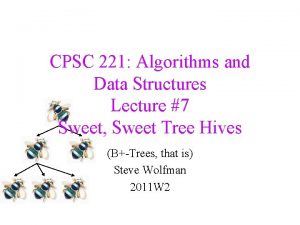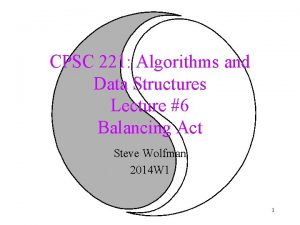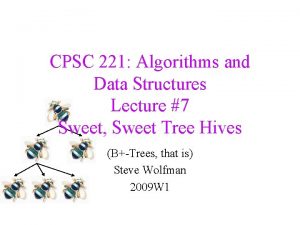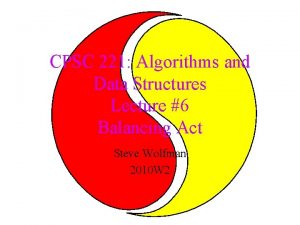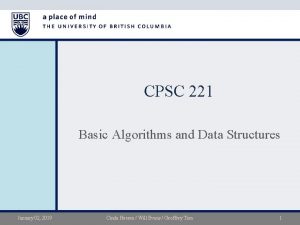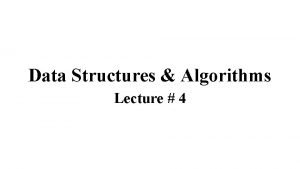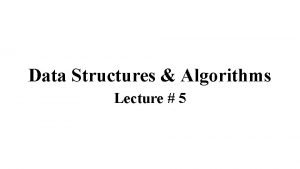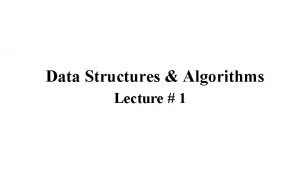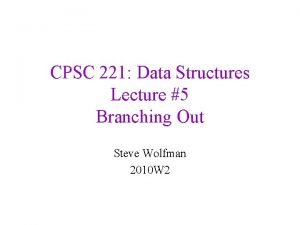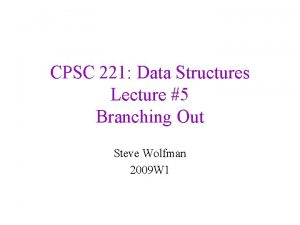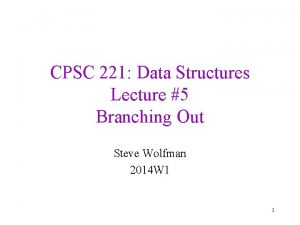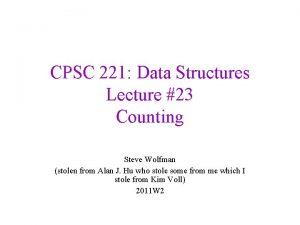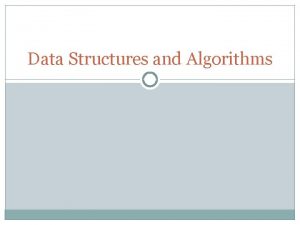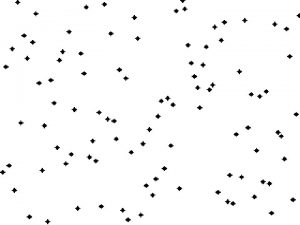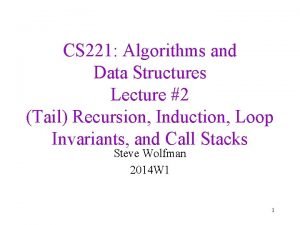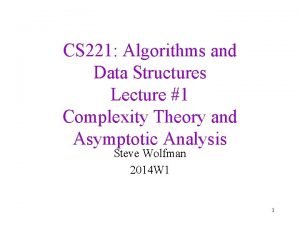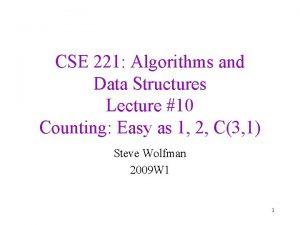CPSC 221 Algorithms and Data Structures Lecture 7


































- Slides: 34

CPSC 221: Algorithms and Data Structures Lecture #7 Sweet, Sweet Tree Hives (B+-Trees, that is) Steve Wolfman 2010 W 2

Learning Goals After this unit, you should be able to: • Describe the structure, navigation and complexity of an order m B-tree. • Insert and delete elements from a B+-tree, maintaining the halffull principle. • Explain the relationship among the order of a B+-tree, the number of nodes, and the minimum and maximum elements of internal and external nodes. • Compare and contrast B+-trees with other data structures. • Justify why the number of I/Os becomes a more appropriate complexity measure (than the number of operations/steps) when dealing with larger datasets and their indexing structures (e. g. , B+-trees). • Describe a B+-Tree and explain the difference between a B-tree and a B+ Tree 2

Today’s Outline • • Addressing our other problem B+-tree properties Implementing B+-tree insertion and deletion Some final thoughts on B+-trees

Cost of a Database Query (10 years ago… more skewed now!) I/O to CPU ratio is 300!

M-ary Search Tree • Maximum branching factor of M • Complete tree has depth = log. MN • Each internal node in a complete tree has M - 1 keys runtime:

Incomplete M-ary Search Tree • Just like a binary tree, though, complete m-ary trees have m 0 nodes, m 0 + m 1 + m 2 nodes, … • What about numbers in between? ?

B-Trees • B-Trees are specialized M-ary search trees • Each node has many keys – subtree between two keys x and y contains values v such that x v < y – binary search within a node to find correct subtree 3 7 12 21 • Each node takes one full {page, block, line} x<3 3 x<7 7 x<12 of memory • ALL the leaves are at the same depth! 12 x<21 21 x

Today’s Outline • • Addressing our other problem B+-tree properties Implementing B+-tree insertion and deletion Some final thoughts on B+-trees

B-Tree Properties • Properties – – – – maximum branching factor of M the root has between 2 and M children or at most L keys/values other internal nodes have between M/2 and M children internal nodes contain only search keys (no data) smallest datum between search keys x and y equals x each (non-root) leaf contains between L/2 and L keys/values all leaves are at the same depth • Result – tree is (log. M n) deep (between log. M/2 n and log. M n) – all operations run in (log. M n) time – operations get about M/2 to M or L/2 to L items at a time

B-Tree ‡ Properties • Properties – – – – maximum branching factor of M the root has between 2 and M children or at most L keys/values other internal nodes have between M/2 and M children internal nodes contain only search keys (no data) smallest datum between search keys x and y equals x each (non-root) leaf contains between L/2 and L keys/values all leaves are at the same depth • Result – tree is (log. M n) deep (between log. M/2 n and log. M n) – all operations run in (log. M n) time – operations get about M/2 to M or L/2 to L items at a time ‡These are technically B+-Trees. B-Trees store data at internal nodes.

B-Tree Properties • Properties – – – – maximum branching factor of M the root has between 2 and M children or at most L keys/values other internal nodes have between M/2 and M children internal nodes contain only search keys (no data) smallest datum between search keys x and y equals x each (non-root) leaf contains between L/2 and L keys/values all leaves are at the same depth • Result – tree is (log. M n) deep (between log. M/2 n and log. M n) – all operations run in (log. M n) time – operations get about M/2 to M or L/2 to L items at a time

B-Tree Properties • Properties – – – – maximum branching factor of M the root has between 2 and M children or at most L keys/values other internal nodes have between M/2 and M children internal nodes contain only search keys (no data) smallest datum between search keys x and y equals x each (non-root) leaf contains between L/2 and L keys/values all leaves are at the same depth • Result – tree is (log. M n) deep (between log. M/2 n and log. M n) – all operations run in (log. M n) time – operations get about M/2 to M or L/2 to L items at a time

Today’s Outline • • Addressing our other problem B+-tree properties Implementing B+-tree insertion and deletion Some final thoughts on B+-trees

B-Tree Nodes • Internal node – i search keys; i+1 subtrees; M - i - 1 inactive entries k 1 k 2 1 2 … ki … __ __ i M - 1 • Leaf – j data keys; L - j inactive entries k 1 k 2 1 2 … kj j __ … __ L

Example B-Tree with M = 4 and L = 4 3 1 2 10 40 15 20 30 10 11 12 3 5 6 9 20 25 26 15 17 50 40 42 30 32 33 36 50 60 70

Making a B-Tree Insert(3) 3 Insert(14) 3 14 The empty B-Tree M = 3 L = 2 B-Tree with M = 3 and L = 2 Now, Insert(1)?

Splitting the Root Too many keys in a leaf! 1 3 14 Insert(1) 1 3 14 So, split the leaf. 14 And create a new root 1 3 14

Insertions and Split Ends 14 14 14 Insert(26) Insert(59) 1 3 14 Too many keys in a leaf! 1 3 14 59 1 3 14 26 59 So, split the leaf. 14 59 1 3 14 26 59 And add a new child

Propagating Splits 14 59 Insert(5) 1 3 5 Add new child 14 26 59 1 3 5 Too many keys in an internal node! 14 59 5 1 3 59 5 14 26 59 Create a new root 5 59 1 3 5 14 26 59 So, split the node.

Insertion in Boring Text • Insert the key in its leaf • If the leaf ends up with L+1 items, overflow! – Split the leaf into two nodes: • original with (L+1)/2 items • new one with (L+1)/2 items – Add the new child to the parent – If the parent ends up with M+1 items, overflow! This makes the tree deeper! • If an internal node ends up with M+1 items, overflow! – Split the node into two nodes: • original with (M+1)/2 items • new one with (M+1)/2 items – Add the new child to the parent – If the parent ends up with M+1 items, overflow! • Split an overflowed root in two and hang the new nodes under a new root

After More Routine Inserts 14 5 1 3 5 59 Insert(89) Insert(79) 14 26 59 14 5 1 3 5 59 89 14 26 59 79 89

Deletion 14 5 1 3 5 14 59 89 14 26 59 79 89 Delete(59) 5 1 3 79 89 5 14 26 79 89

Deletion and Adoption A leaf has too few keys! 14 5 1 3 5 14 Delete(5) 79 89 14 26 79 ? 1 3 89 P. S. Parent + neighbour pointers. Expensive? a. Definitely yes b. Maybe yes c. Not sure d. Maybe no e. Definitely no 79 89 14 26 79 So, borrow from a neighbor 14 3 1 3 79 89 3 14 26 79 89 89

Deletion with Propagation A leaf has too few keys! 14 3 1 14 Delete(3) 79 89 3 14 26 79 ? 1 89 79 89 14 26 79 89 And no neighbor with surplus! But now a node has too few subtrees! WARNING: with larger L, can drop below L/2 without being empty! (Ditto for M. ) 14 So, delete the leaf 79 89 1 14 26 79 89

Finishing the Propagation (More Adoption) 14 79 Adopt a neighbor 79 89 1 14 26 79 89 14 1 89 14 26 79 89

A Bit More Adoption 79 79 14 1 14 26 79 89 89 Delete(1) (adopt a neighbor) 26 14 26 89 79 89

Pulling out the Root A leaf has too few keys! And no neighbor with surplus! 79 79 26 14 26 89 79 Delete(26) 89 14 89 But now the root has just one subtree! 79 89 A node has too few subtrees and no neighbor with surplus! 79 79 89 14 79 89 So, delete the leaf Delete the leaf 89 14 79 89

Pulling out the Root (continued) The root has just one subtree! 79 89 14 79 Just make the one child the new root! 89 But that’s silly! 79 89 Note: The root really does only get deleted when it has just one subtree (no matter what M is). 14 79 89

Deletion in Two Boring Slides of Text • Remove the key from its leaf • If the leaf ends up with fewer than L/2 items, underflow! – Adopt data from a neighbor; update the parent – If borrowing won’t work, delete node and divide keys between neighbors – If the parent ends up with fewer than M/2 items, underflow! Will dumping keys always work if adoption does not? a. Yes b. It depends c. No

Deletion Slide Two • If a node ends up with fewer than M/2 items, underflow! – Adopt subtrees from a neighbor; update the parent – If borrowing won’t work, delete node and divide subtrees between neighbors – If the parent ends up with fewer than M/2 items, underflow! • If the root ends up with only one child, make the child the new root of the tree This reduces the height of the tree!

Today’s Outline • • Addressing our other problem B+-tree properties Implementing B+-tree insertion and deletion Some final thoughts on B+-trees

Thinking about B-Trees • B-Tree insertion cause (expensive) splitting and propagation (could we do something like borrowing? ) • B-Tree deletion cause (cheap) borrowing or (expensive) deletion and propagation • Propagation is rare if M and L are large (Why? ) • Repeated insertions and deletion cause thrashing • If M = L = 128, then a B-Tree of height 4 will store at least 30, 000 items

A Tree with Any Other Name FYI: – B-Trees with M = 3, L = x are called 2 -3 trees – B-Trees with M = 4, L = x are called 2 -3 -4 trees Why would we ever use these?

Coming Up • Graph Theory and Counting
 Cpsc 221 ubc
Cpsc 221 ubc Cpsc 221
Cpsc 221 Csce 221 tamu syllabus
Csce 221 tamu syllabus Professor ajit diwan
Professor ajit diwan Kevin wayne princeton
Kevin wayne princeton Data structures and algorithms tutorial
Data structures and algorithms tutorial Information retrieval data structures and algorithms
Information retrieval data structures and algorithms Data structures and algorithms bits pilani
Data structures and algorithms bits pilani Ajit diwan iit bombay
Ajit diwan iit bombay Data structures and algorithms
Data structures and algorithms Data structures and algorithms
Data structures and algorithms Waterloo data structures and algorithms
Waterloo data structures and algorithms Signature file structure in information retrieval system
Signature file structure in information retrieval system Data structures and algorithms
Data structures and algorithms Algorithms + data structures = programs
Algorithms + data structures = programs Analysis of algorithms lecture notes
Analysis of algorithms lecture notes Introduction to algorithms lecture notes
Introduction to algorithms lecture notes 01:640:244 lecture notes - lecture 15: plat, idah, farad
01:640:244 lecture notes - lecture 15: plat, idah, farad Homologous structures example
Homologous structures example Stream data model
Stream data model Csce 221 tamu syllabus
Csce 221 tamu syllabus Phy 221 msu
Phy 221 msu 866-221-0269
866-221-0269 Cap 221
Cap 221 Sp 221
Sp 221 Emmett school district 221
Emmett school district 221 Epsc 221
Epsc 221 Cpit 221
Cpit 221 Qin dynasty (221-206 b.c.e.)
Qin dynasty (221-206 b.c.e.) Cpit 221
Cpit 221 15 cienmilésimos
15 cienmilésimos Aca 221
Aca 221 Fin 221
Fin 221 Cse 221
Cse 221 Cs 221
Cs 221
